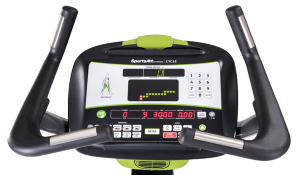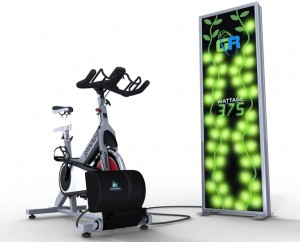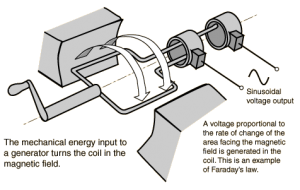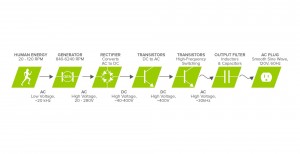Technical Analysis (GK)
For a sometime people have been harnessing human power on bicycles to power lights at night while they ride. Power generating workout equipment use similar techniques to harness the energy a person generates while on an aerobic machine, such as a stationary bike or elliptical. Using inverters and controllers, much like ones developed for solar or wind energy, current machines are able to be retrofitted to become green aerobic machines. It is also possible, using the same technology, for companies to design and manufacture their own machines from scratch. (Gibson. 2011)
There are two options available to us when it comes to harvesting energy from exercise equipment. We have looked at several manufacturers that specialize in doing this and we have compared the different services that they provide. In particular, three companies stood out as being especially feasible both technically and economically: SportsArt , ReRev, and Green Revolution.
SportsArt provides the client with a selection of new ellipticals and bikes that have a built in energy conversion system. A section of the company, called ECO-POWR, offers 14 different regenerative bike and elliptical models. These machines plug directly into a 120-V outlet and the excess energy that is produced goes back into the facility’s power grid which offsets energy costs. They also have a visual interface that shows the user how much energy they are producing over time. This interface also has a variety of different fitness games that keep the user entertained during an exercise session. (gosportsart)

We would lean towards this option if the majority of the machines in the facility were outdated or in need of repair. If so, it would be more feasible to completely replace the aged equipment by consulting with SportsArt. According to Lafayette’s director of facilities operations, the typical turnover rate for the exercise equipment is 5-10 years. (Xiques. 2015)
In contrast, ReRev and The Green Revolution retrofit existing exercise equipment with this system so that the client does not have to pay for a completely new set of machines. (Gibson. 2011) As seen in the figure below, an external energy converter would be attached to the equipment.

A thorough inspection of the quality of each individual bike and elliptical would need to be performed before choosing a specific manufacturer. This process would also involve filling out a facility assessment form with information regarding the size of the facility, how often it is used, and the models of each bike and elliptical. (ReRev)
How Does This Energy Conversion Technology Work?
Most types of cardiovascular exercise equipment have an internal wheel that rotates when the user exerts physical energy. It is possible to capture this rotational energy by capitalizing on the piezoelectric effect. The piezoelectric effect is present in materials that generate electric potential in response to a mechanical load. (Kofinas. 2009) A simplified example would be a microphone. The user sends sound waves that exert pressure on the internal microphone system which changes its internal electrical response and results in an acoustic signal. (comsol) We considered applying this same idea to rowing machines, however there are complications due to the fact that this particular type of equipment does not have the ability to produce energy at a continuous rate. A rowing machine operates based on a series of physical pulses that are produced when the user performs each stroke. It may still be possible to harness short bursts of energy but this ‘pulse’ effect would adversely affect energy generation. (Kofinas. 2009)
Many of today’s workout equipment are already fitted with generators. These generators supply the power for the equipment’s display screens by converting mechanical energy into AC power. These display screens do not require much power for operation, and typically the user generates more electrical power than the machine needs. This excess energy is fed through resistors that dissipate it as heat. A retrofitted system would send this excess energy to the building’s electrical grid. (Lovgren. 2011)
As seen in the figure below, the rotational mechanical energy turns a coil that produces a voltage proportional to the rate of change of the area between the two magnets. This results in a sinusoidal voltage output. (Generators)

This voltage output (anywhere from 20-280V) is sent to a rectifier that converts AC to DC power. This is necessary because sometimes AC (alternating current) power can switch directions and DC (direct current) power only flows in one direction. (techopedia) This DC power is sent to a a high-frequency sine-wave inverter that converts DC into 3-phase AC power. (Freitas. 2010) Inside this inverter, there are two types of transistors: field effect transistors that control the voltage flow and bipolar junction transistors that amplify the voltage which maximizes energy output. (learningaboutelectronics) The energy travels to an output filter that reduces the frequency of the sine wave to 60 Hz so that the energy can travel through a typical AC outlet. (hyperphysics)

How Much Energy Can Be Produced?
A person who is in decent shape can generate anywhere from 60 to 120 watts during an hour of strenuous exercise. Comparatively, an elite cyclist can average about 300-400 watts. If, in an hour long workout, the person using the machine is averaging approximately 75 watts they are producing 75 watt-hours of energy. ReRev has figured out that 50 watt-hours of electricity can power a compact fluorescent light bulb for two and a half hours, a cell phone charger for six full charges, a laptop for one hour, and a desktop computer for thirty minutes. (Gibson. 2011) Additionally, we have taken a look at several case studies involving schools that have planned and executed similar projects. In 2009, the University of Maryland performed a study that sought to identify the benefits of implementing human energy harvesting technology in gym exercise equipment. They performed a number of surveys that kept track of peoples exercising habits as well as the potential energy that can be produced. They discovered that most people go to the gym 2-3 times a week and use cardiovascular workout equipment for 25-30 minutes per session. They also found that retrofitted elliptical trainers generate approximately 0.1 kW of power each per day. This would only decrease grid dependence by a small fraction. (Kofinas. 2009) According to Lafayette’s director of facilities operations, the fitness center’s annual energy consumption is 214,500 kWh. (Xiques. 2015) If 10 machines were used 8 hours per day for a year, approximately 2,900 kW would be saved. This means that only 1.35% of the facility’s annual energy consumption would be saved.
Next Page: Economic Analysis
Previous Page: Policy Analysis
